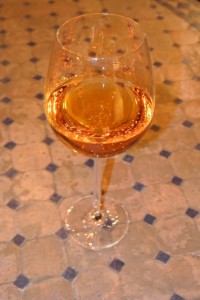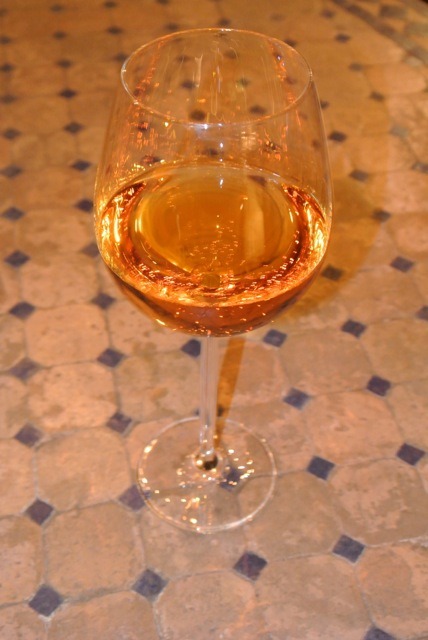Only two bottles of the wine we brought back from Friuli-Venezia Giulia in 2010 were left in the wine fridge. I thought they were both the varietal Friulano, and I wanted to write about the controversy that led a few years ago to the change in the name of this wine from Tocai Friulano to simply Friulano. (More on this in a minute.) I also wanted to enjoy this crisp, dry white with the fish Joe was grilling. But we were in for a surprise: the bottle said “Friulano” alright, but first it said Verduzzo. Verduzzo Friulano is a completely different animal.
My first clue should have been that this “white” wine, as it came out of the bottle, was a deep orange-honey color. In retrospect I also realized it had just slightly more viscosity in the glass than most “regular” wines, but the difference was so slight that it took a sip, even with the color, to realize that this wasn’t the wine I had been expecting. Joe made a face and put down his glass. “This is sweet,” he grimaced, “I can’t drink this with the meal.” When I think of Friulian dessert wine, I think Picolit, which comes, as many dessert wines do, in a small, dessert-wine bottle. But the Verduzzo Friulano was in a full 750ml. bottle. And the thing about this wine was that while it was sweet, it was also very light: nearly on the order of a Riesling, with still enough acidity to pair—for me, if not for Joe—with our fish. Plus, having opened one of our last two remaining bottles from Friuli, I wasn’t about to let it go to waste!
Looking back, I think we might have brought the Verduzzo Friulano home as a dessert wine, not a “regular” white, but Verduzzo is used for a range of wines from dry to dessert, and this particular example fell in a fascinating place on the spectrum. Very light, like some of the German and Austrian wines that wine critics rave about pairing so well with so many foods, but which haven’t become popular yet to most of us Americans. Too sweet for Joe, but my sister, the Riesling fanatic, would have been in heaven!
As for that controversy: Tocai Friulano was always the name of a distinct varietal that makes a crisp, light, wonderful white something like Sauvignon Blanc (and is also known as Sauvignon Vert). But the Friulian word Tocai could be confused with the Hungarian Tokaj or Tokaji, which is the name of a completely different wine (one that has no Tocai Friulano in it). Or so said Hungary, which kept complaining until the international wine poo-bahs forbade Friuli-Venezia Giulia from using Tocai as part of their wine’s name, leaving it to be called simply Friulano.
So what I thought was (don’t let the Hungarians know I’m using this term) Tocai Friulano last night turned out to be—surprise—Verduzzo Friulano. A sweet surprise, but fortunately not too sweet (for me), and actually versatile enough to pair quite well with our meal. We’ll probably save our other bottle of Verduzzo Friulano for a time when the sweetness of this particular wine is part of the game plan, but I’m eager to try more versions of Verduzzo. And exploring wine sometimes means being up for a surprise!


Dried-grape Verduzzo can be so amazing! Especially when it’s older… And Ramandolo (village) and Nimis (comune) are so beautiful… Great post… and so glad you’re enjoying such great wines… who was the producer?
That is MY kind of surprise! It looks like a lovely color, and you are so wise for not letting it go to waste…!